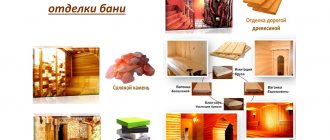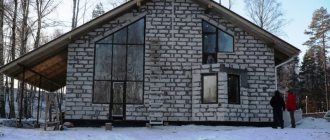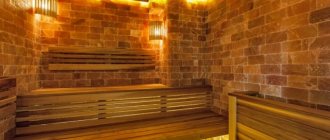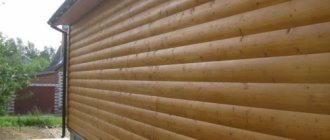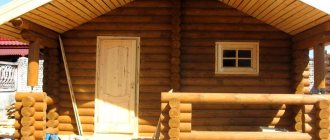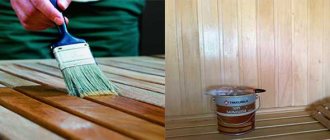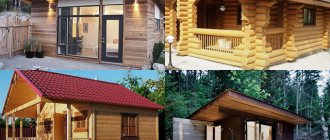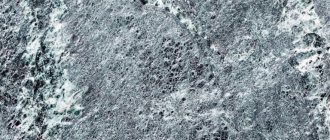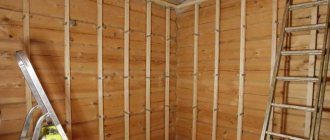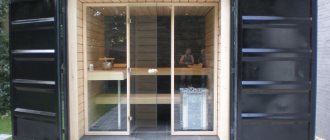Description and production technology of the material
Block house is an environmentally friendly material used for external and internal decoration of buildings. Treatment:
- The edges of the log are trimmed to produce a block house.
- The central part is used to make boards and timber.
If the production is private, the material is made from edged boards using special equipment - a four-sided milling machine.
In the manufacture of panels, wood with a moisture content of no more than 13% is used. It will not dry out or crack due to temperature changes.
Production
The production process consists of the following stages:
- logs are sawn according to the “Square in a circle” technology;
- the wood is dried in a special chamber (humidity up to 12%);
- dimensions are adjusted, grooves are cut, combs are made, grooves are created;
- the material is polished;
- raw materials are treated with antiseptic and antifungal compounds;
- product quality is checked;
- the goods are packaged.
Thus, a popular finishing material is born. Although some people prefer imitation timber. As they say: how many people - so many opinions...
Sheathing for block house
Material characteristics
The scope of application and capabilities of the material are determined by its technical characteristics:
- In the production of block houses, ash, oak, aspen, larch, pine, and cedar are used.
- The panels are manufactured in two versions - wide and narrow. In the first case, the width of the products reaches 190 mm and the thickness - 45 mm. Narrow panels should have a thickness of 27 mm and a width of 140 mm.
- The humidity level of finished models should not exceed 13%. To remove excess moisture, chamber drying is carried out.
- It is possible to manufacture panels 2–6 meters long.
Bathhouse cladding with imitation timber
Imitation timber is a type of lining that is used for cladding facades. Board dimensions: thickness – 1 cm, width – from 10 to 16 cm.
A distinctive characteristic of the material is the presence of a central groove to relieve stress in the wood, which helps extend the service life of the finish.
Imitation wood is made from various species, but coniferous wood is considered the best.
The main advantages of the finishing material include:
- environmental safety;
- affordable and quick installation;
- resistance to aggressive substances and damage;
- aesthetics;
- variety of standard sizes - width, length and thickness;
- high thermal insulation characteristics;
- long service life.
But even such a practical material is not without significant drawbacks:
- the need for periodic treatment with antiseptics and fire retardants;
- susceptibility to fire and rot;
- the possibility of deformation due to insufficient drying or the use of low-quality raw materials for manufacturing.
The log house of the bathhouse is sheathed horizontally with the tenon facing outwards. This type of fastening is resistant to deformation and moisture penetration. The material is mounted on a flat surface using wooden or metal sheathing. Before painting, the imitation wood is carefully sanded with fine-grain sandpaper.
Varieties
Depending on the quality and performance characteristics, the block house can be divided into 4 classes:
- C is the lowest quality class. Finished panels may have cracks, chips, knots, and unevenness.
- B - second quality class. The panels are smoother and cleaner, but there are cracks and darkening of the wood.
- A - high-quality panels that undergo additional polishing at the enterprise. Sometimes there may be large knots.
- Top class. Surfaces are brought to perfect condition. The panels are used for cladding walls inside the building.
When purchasing a block house, you need to check the humidity level. It is not recommended to use damp or too dry panels. They will quickly lose strength and become unusable.
Calculation of the cost of finishing a bath
If you have become familiar with the nuances of block house finishing and decided to use this finishing material to furnish your bathhouse, you will need to calculate the approximate cost of the material. You can perform the calculations yourself or use the online calculators available on the websites of block house manufacturers.
Having decided to calculate the cost of the material you need yourself, you will need to clarify the dimensions of the interior space to be finished or the facade of the bathhouse. Based on these data, the calculation is made. In this case, it would be better to make a small supply from the same batch in case you need to replace, for example, broken boards.
In addition, when drawing up an estimate for construction and repair work, it is necessary to include the costs of accessories, tools, consumables and fasteners. They also need to be taken in reserve, since a shortage of the same screws can significantly delay the finishing work. As for tools, it is worth renting or purchasing a jigsaw, which will save you a lot of time cutting the block house.
If it is difficult for you to calculate the cost of finishing on your own, you can use online calculators. To work with them, you will only need to enter the required information in a special form, and all calculations will be made automatically. At the same time, you can immediately place an order online, which will be delivered to you directly to the construction site.
Advantages and disadvantages
Positive aspects of the material:
- Environmental friendliness. The material does not emit harmful substances during operation.
- Resistant to temperature changes.
- High strength, durability.
- Ease. Thanks to this indicator, the load on the foundation and walls is reduced.
- Quick elimination of defects. If the integrity of the panels is compromised, the unevenness can be corrected using a sanding machine.
- Easy to install. You can secure the block house without the help of specialists.
- High sound insulation rate.
- Attractive view. The wood does not need to be painted.
Flaws:
- Without additional coating with protective compounds, the wood will deteriorate when exposed to moisture for a long time. Fungus and mold may appear on it.
- Susceptibility to fire.
- Moisture may accumulate under the casing.
Antiseptics must be reapplied every year.
How is the lining done inside the bathhouse?
We have already said above that it is best to sheathe surfaces inside baths and saunas with extra-class and first-class boards. Of course, if you want to see naturalness in literally everything, in this case the best option would be a first-class block house. The fact is that if you use extra-class boards for finishing, whose surface, as people say, “without a hitch,” then the cladding will not look so natural.
Sheathing work must be carried out when waterproofing and thermal insulation have been completed. You will also need to thoroughly prepare all surfaces for sheathing. First, the lumber must be treated with a special antiseptic, this will help avoid rotting processes. Next, the sheathing is made, and finishing lumber will be attached to it.
The hardest part about paneling is installing the boards in the corners. The solution here could be the following move: cut the boards from the end to the shape of a block house located in a perpendicular position. It should also be noted that cladding with a blockhouse requires the creation of high-quality fire safety; for this, treating the boards with special fire retardants alone is not enough; you will also have to perform reliable insulation in those places where the chimney and heating devices will be located. To create high-quality insulation, basalt wool is used.
Selection principles
Selection rules:
- To decorate a washing room, dressing room, and relaxation area, it is better to choose products made from hardwood. They are resistant to moisture.
- For the steam room, finishing material made of ash or alder is suitable. These rocks have low thermal conductivity.
Polymers cannot be used to decorate steam rooms. They quickly deform and become very hot.
Description of different breeds:
- Birch. Suitable only for finishing rooms with low humidity levels.
- Aspen. The material quickly cracks when exposed to temperature changes or prolonged exposure to moisture.
- Alder. Suitable for finishing the inside of baths. Tolerates temperature changes well and withstands heavy loads.
- Ash. Suitable for finishing baths outside and inside. Withstands temperature changes and prolonged exposure to moisture. Has high density and elasticity.
- Larch. It has an attractive appearance and improved performance.
Which material is better for a bathhouse: linden or aspen?
Both lumber have their pros and cons. If you choose between these two lumbers, then of course linden. Such lumber has higher strength characteristics and better withstands exposure to high temperatures and moisture. As for aspen, it is better not to use it for lining the inside of a bathhouse.
Firstly, the material is afraid of moisture and hot air, and secondly, if damage in the form of chips or scratches appears on such a lining, then a rotten area will form in this place.
Application
Working with a block house is easy. To do this, it is enough to have basic skills in using hand and power tools, and to properly prepare decorative material and work surfaces.
Tools
To carry out finishing work you need to prepare:
- miter saw;
- hand saw for wood;
- grinding machine;
- hammer, finishing nails.
You will also need brushes, paints and antiseptics.
Preparation
Features of wall preparation:
- Impregnate wooden panels with protective compounds.
- Using a miter saw, cut the block house to the required dimensions. Clean the ends.
- Level the surfaces by assembling the sheathing.
- Lay insulation.
- Secure the foil.
- Lay a layer of waterproofing.
- Stuff the sheathing with slats.
External wall preparation:
- Place the wooden panels under the roof and leave for 3 days so that the finishing material gets used to the humidity and ambient temperature.
- Cover the boards with an antiseptic. The protective composition must be applied in 2 layers.
Cover working surfaces with heat and waterproofing.
Internal lining
Rules for finishing a bathhouse with a block house from the inside:
- The spikes should be positioned upward. This will protect the grooves from moisture accumulation.
- You can start sheathing from the bottom or the top.
- You can join corners by creating cuts at an angle of 45° or stuffing slats.
An example of the interior decoration of a bathhouse with a block house
Exterior finishing
Installation:
- The boards are cut to the required sizes, the ends are cleaned with a sanding machine.
- The panels are secured with nails or self-tapping screws.
The last stage is stuffing the platbands.
Processing and coloring
Treating a block house with protective compounds increases the service life of the material and improves its appearance. You can impregnate the wood yourself:
- Fire retardant compounds. Designed to protect wood from fire.
- Antiseptics. Prevents the formation of fungus and mold.
Universal impregnations have several protective properties.
For decorative finishing you can use azure. It penetrates deeply into the wood and improves its performance characteristics. There are several types of azure:
- alkyd-oil;
- alkyd;
- acrylic-oil.
Before applying the glaze, the panels must be coated with a primer and antiseptic. Varnishes cannot be used for cladding walls outside the building, since they cannot protect the cladding material from exposure to precipitation.
The block house in the bathhouse is a natural product in all respects
A log bathhouse is a very expensive pleasure, and also not always practical - the structure in the northern regions still has to be insulated, so all the beauty of using a log house is negated. In such cases, it is much better to build a bathhouse from foam blocks or on a frame made of timber, and insulate it according to all the rules. However, then the dream collapses - what about a log bathhouse? A dream is sacred, so if it is impossible to take a log house as a basis, we will take it as a decoration. Or rather, not the log house itself, but a special finishing material - a block house.
In their finished, assembled form, bathhouses lined with a block house cannot be distinguished from those built from logs - the material so accurately imitates the rounded shapes of a log house. This is achieved thanks to the rounded shape of the front layer of wood. Unlike conventional wood siding, block house is made of massive and thick boards. There is a block house for logs and similar material for timber.
By the way, today you can find four varieties of this type of finish on the market:
- natural block house is made of sheet and coniferous wood;
- vinyl block house is made from polyvinyl chloride powder;
- acrylic material is made from polymer resins;
- The metal block house is made of galvanized steel.
The last three types of products not only imitate the shape of a log, but also repeat the color and texture of the material - a direct imitation in a square. However, there is nothing to reproach manufacturers for - although a wooden block house is cheaper than using logs, the price still remains high. Synthetic and metal products allow you to save on external finishing, and there is less hassle with them - they do not need to be impregnated from time to time with fire retardants and antiseptics, sanded and cleaned of dust. Even wash them with a hose, nothing will happen to them! Processing a block house made of wood should happen every few years if you want it to last for decades.
But only a wooden block house is suitable for interior decoration, and not all of it. There is a division of materials into classes:
- Class “C” is the lowest quality block house, with conventional surface treatment. Any number of knots, cracks, bark residues and darkening of wood is allowed
- Class “B” is a block house of acceptable processing, with knots with a diameter of no more than 3 cm and a limited number of them - no more than 4 pieces per meter. Small cracks and chips are allowed.
- Class “A” – clean processing, no cracks, chips or darkening. The presence of small knots with a diameter of up to 3 mm is acceptable.
- “Extra” class is the highest and most expensive class of product. No mechanical damage, cracks, or darkening is allowed. The surface is processed perfectly, this is what they say about “no hitch.” By the way, there shouldn’t be any knots on it.
When choosing, be very careful - the seller may give you class “A” for extra class, or increase the cost of class “B”. However, for internal processing, the “Extra” and “A” classes are best suited, while with the “B” and “C” block houses, you can’t do anything else except sheathe the outside of a bathhouse or other structure.
Recommendations
To avoid difficulties when working with a block house, you need to take into account the recommendations of experienced builders:
- Exterior finishing work cannot be carried out in the cold or during rain.
- When choosing a material, you need to inspect it for chips, cracks, unevenness, darkening, and through knots.
- Before installation, the boards must lie indoors for 3 days.
- The choice of fasteners depends on the thickness of the wooden panels. Up to 21 mm - nails. Thickness over 21 mm - self-tapping screws. Fasteners must be coated with an anti-corrosion compound. Their length should be 1.5 times greater than the thickness of the boards.
- For the outer cladding of a bathhouse, it is better to use panels of greater thickness.
- It is prohibited to attach a block house to walls without hydro- and thermal insulation.
For wooden surfaces located inside bathhouses, it is better to choose antiseptics with the lowest content of harmful substances.
Block house is a popular material used for decorative finishing of bathhouses outside and inside. The panels have an attractive appearance and improved technical characteristics.
Classification
Before you begin finishing work, you need to know what type of product to give preference to.
1.) Panel size. Sheathing raw materials come in different sizes, but the following parameters are considered common (thickness - width - length):
- 36x190x6000 mm;
- 36x190x2000 mm;
- 30x140x6000 mm;
- 30x140x2000 mm;
- 20x90x6000 mm;
- 20x90x2000 mm.
2.) Type of wood. Products are divided into the following classes:
- “Extra” – finishing raw materials that do not have any defects;
- “A” – facing material, characterized by the presence of one knot, two resin pockets, one non-through crack;
- “B” – sheathing panels showing the presence of four knots, two resin pockets, two blind cracks and one deep shade stain;
- “C” is a decorative raw material known for the presence of a number of defects - stripes, spots, knots, “pockets”, non-through cracks, mechanical defects.
3.) Breed. The block house is made from the following types of wood:
- graceful pine;
- elegant spruce;
- exquisite fir;
- noble cedar;
- majestic larch;
- refined linden;
- graceful aspen, etc.
There is plenty to choose from! Is not it?
Exterior cladding
Installation of a block house from the outside
For external installation, boards up to 142–230 mm wide and 35–40 mm thick are used. Cladding work begins with covering the walls with a layer of waterproofing. A vertical sheathing of beams 50 by 50 mm or 40 by 50 mm is placed on it. At this stage, the walls of the bathhouse are insulated. The best material for thermal insulation is mineral wool. Its thickness depends on the region; in a temperate climate, a layer of 5 cm is enough, and in a cold climate, 10 cm is required. The size of the sheathing will increase accordingly.
A wind protection fabric is stretched over the laid insulation. It will protect the material from getting wet. The membrane is secured with a stapler. The joints of the canvases are glued together with tape for tightness. A second, smaller batten is placed on top of the windbreak. It is attached to existing beams and provides space for ventilation of the blockhouse.
Finish structure
Holes for self-tapping screws are pre-drilled in the finishing boards, which are the optimal fasteners for lumber. During installation, the panels are positioned with the tenon facing upward to prevent moisture accumulation. Ventilation gaps are left at the bottom and top of the cladding; 1–2 mm is also needed for free expansion at the joints of the boards. The fastening of the block house begins from the bottom, fastening the boards with a lock and self-tapping screws, which are inserted into the prepared holes. The fastener caps are covered by the next panel of the block house. The finished surface is treated with several layers of tinting varnish for protection and attractiveness.
